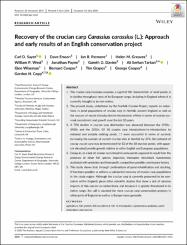Recovery of the crucian carpCarassius carassius(L.): Approach and early results of an English conservation project

View/
Date
2020Author
Sayer, Carl D.Emson, Dave
Patmore, Ian R.
Greaves, Helen M.
West, William P.
Payne, Jonathan
Copp, Gordon H.
Tarkan, Ali Seyhan
Metadata
Show full item recordAbstract
The crucian carpCarassius carassius, a cyprinid fish characteristic of small ponds, is in decline throughout most of its European range, including in England where it is currently thought to be non-native. The present study, undertaken by the Norfolk Crucian Project, reports on reductions in pond populations of crucian carp in Norfolk, eastern England as well as the success of recent introduction/re-introduction efforts in terms of crucian survival, recruitment and growth over the last 10 years. A 72% decline in crucian carp distribution was observed between the 1950s-1980s and the 2010s. Of 18 crucian carp introductions/re-introductions to restored and suitable existing ponds, 17 were successful in terms of survival, increasing the number of current crucian sites in Norfolk by 37%. Recruitment of young crucian carp was demonstrated for 12 of the 18 stocked ponds, with apparent elevated juvenile growth relative to other English and European populations. Delays in, or a lack of, crucian recruitment in some ponds appeared to result from the presence of other fish species (especially threespine sticklebackGasterosteus aculeatus) with predation and interspecific competition possible contributory factors. This study shows that, through combinations of pond rehabilitation and stocking, it has been possible to achieve a substantial recovery of crucian carp populations in the study region. Although the crucian carp is currently presumed to be non-native within England, given other scientific studies that show a lack of adverse impacts of this species on native biota, and because it is greatly threatened in its native range, the call is sounded for more crucian carp conservation projects in other parts of England as well as in Europe more generally.

















